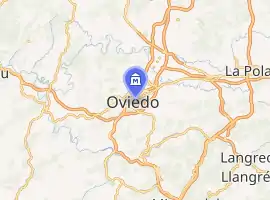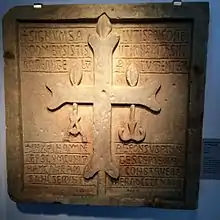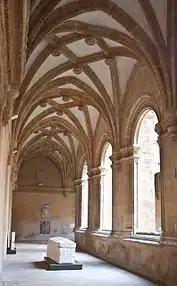Archaeological Museum of Asturias
The Archaeological Museum of Asturias (Spanish: Museo Arqueológico de Asturias; Asturian: Muséu Arqueolóxicu d'Asturies) is housed in the 16th century Benedictine monastery of Saint Vicente in Oviedo, Asturias, Spain. Its findings include collections of the Asturian Neolithic, Megalithic, Bronze Age, Iron Age, Astur hill fort culture, Roman period, and of the Gothic, Pre-Romanesque and Romanesque periods of the Kingdom of Asturias. The museum also includes sections of Asturian Ethnography, Heraldry, Medieval and Modern Epigraphy, Spanish Numismatics, a European Medal Section, and Armor.
Museo Arqueológico de Asturias | |
 | |
 | |

| |
| Established | 1952 |
|---|---|
| Location | Calle San Vicente 3 and 5 Oviedo, Asturias, Spain |
| Coordinates | 43.3625°N 5.8423°W |
| Website | http://www.museoarqueologicodeasturias.com |
While owned by the Spanish State, its management was transferred to the regional administration in 1991.[1]
The museum underwent a series of refurbishment works beginning in 2004, being reinaugurated and reopened to the public on March 21, 2011.[2][3]
Notable pieces
- Vega del Cielo mosaic
- San Miguel de Lillo altar stone
- Santa María del Naranco altar stone
- 12th-century sarcophagus of Gontrodo Pérez, lover of King Alfonso VII of León and mother of Urraca la Asturiana., Queen of Navarre
Permanent exhibits
.jpg.webp)
The permanent exhibition narrates the history of the Asturian region from prehistory to the High and Late Middle Ages, through the material culture preserved in the museum, giving us a view of the different peoples that have inhabited this territory over its many centuries of history.
Prehistoric Times
Archaeological investigations have revealed the subsistence strategies (hunting, fishing and foraging) and technical advances in the manufacture of tools of the prehistoric people who occupied caves and shelters near rivers. Of particular note is the presentation of the world of the Neanderthals, provided by the latest discoveries in the Asturian cave of El Sidrón. The enigmatic universe of the different mindsets finds its most eloquent expression in Paleolithic parietal art and furniture. In Asturias, images of great beauty are to be found in nearly fifty caves, where our remotest ancestors carved or painted animals, symbols and summary representations of the human body.
Neolithic Metal Ages

From the Neolithic up through the Bronze Age, a drastic cultural change occurred as compared to the traditional way of life of Paleolithic societies. The people that populated our region about 4,500 years ago felled forests, cleared the first fields for crops and opened up areas of pasture land for raising animals. Megaliths, with their ritualistic and territorial significance, became a part of the Asturian landscape as a reflection of the complex new agricultural society. The intensive exploitation of copper mines and the expansion of the metallurgical phenomenon led to the development of increasingly complex societies. During this period, Asturias began its long history as a mining region.
Era of the Castros
The castros (fortified settlements) nowadays constitute one of the most visible elements of the Asturian landscape, the typical habitat in Asturias between the end of the Bronze Age and Roman settlement, i.e., during the Iron Age. The castros had an autonomous nature, with the defenses being the most outstanding boundary element, emblematic of these communities that appeared to be quite dissociated and divided into clans.
Rome in Asturias

With the arrival of Rome to the distant lands bordering the Bay of Biscay in the times of the emperor Augustus, Asturias became part of the Roman Empire. Under Roman rule, the territory became truly unified due to the creation of both urban and rural centers connected by an extensive network of roads. Profit from the gold mines focused Rome's attention on the western area of the region, exploiting deposits on a large scale. New economic and trade activities arose throughout the country, bringing about a change in the habits and customs of a traditionally mining and agricultural population. The presence of Rome in Asturias also marked our region's entrance into the cultural spheres of the classical world.
Medieval Asturias

The Kingdom of Asturias inaugurated the Middle Ages in this region. Royal sites, churches, monasteries and castles comprised the main centers of power of the monarchy and the early medieval aristocracy. However, most of the rural population lived in modest houses with simple household furnishings in small villages. The art of the Astur monarchy is noted for its architectural and ornamental originality. From the 13th century on, new urban centers and towns (Asturian polas) concentrated the population and centralized administrative, trade and craft activities. New Romanesque and Gothic churches were built in these cities, towns and villages. Towards the end of medieval times, there emerged a new aristocracy which played a major role in the political, economic and social life of the region.
Completing the exhibition a specific section entitled “From Collection to Museum”, which looks at how the Museum came to be, its history running almost parallel to the beginnings of scientific archeology in the region.
In an annex to this thematic area is a tribute to the figure of Friar Benito Feijoo y Montenegro, extraordinary figure of the Spanish Enlightenment and abbot of the Monastery of San Vicente. A Benedictine cell has been reconstructed in the grandest part of the old cloister, just like the one found in the Museum's former exhibition. In this way, we continue to recognize the most prolific essayist of the 18th century, whose intellectual work marked a milestone in the evolution of thought and science of that time.
Another section is devoted to the dissemination and appreciation of World Heritage sites in Asturias: Paleolithic cave art and monuments of the Asturian monarchy. Through a series of interactive screens and audiovisuals, visitors are given relevant information on these heritage sites as well as the various archaeological routes that can be taken to enjoy this cultural legacy.
The collection
.jpg.webp)
The confiscation of church property in 1837 put a great number of religious works of art into circulation and throughout the 19th century the Asturian Commission on Monuments took on the task of collecting the remains of those abandoned and sold-off monasteries and churches. These pieces constituted the source of the Museum of Antiquities’ collection, which gradually grew through the donations made by several of its members, as well as by collectors and scholars concerned with the past.
In its active work, the museum was mainly involved in the restoration of pre-Romanesque churches, collecting pieces from the ruins of some of these buildings. Once in the 20th century, the development of scientific archeology meant expanding the horizon towards prehistoric times, after Palaeolithic cave art was discovered in Asturias.
Throughout the 20th century, the museum's collection grew significantly as the result of archaeological excavations in Asturias. Private collections were also donated, adding to the holdings of the former Commission on Monuments. Throughout the 1960s and 1970s, the Provincial Government of Oviedo purchased a variety of wooden statues, furniture and other objects. Major purchases included three collections: that of the heirs of Soto Cortés, comprising all kinds of archaeological artifacts; the numismatic collection belonging to Pedro Hurlé Mansó; and the collection of arms and coins from the heirs of Tomás Fernández Bataller.
Research carried out since the 1970s has steadily expanded the museum's collection from the Paleolithic Age, the Metal Ages and the Roman period. The birth of archeology management, which has developed significantly since the 1990s, has led to a great deal of material from all ages being incorporated. This especially includes objects from the Middle Ages, collected from the historic centers of Asturian cities and towns, as well as from the numerous churches and monasteries which have been examined prior to their restoration.
History

The precedent for the current museum lies in the Provincial Commission on Monuments, created in 1845, which carried out the first actions to protect the monuments and cultural heritage of Asturias, opening the first museum in 1870 in the Convent of San Francisco, which has since ceased to exist, with pieces collected throughout the Asturian region as well as from private donations.
The current museum dates from 1944, although it was not opened to the public until 1952 in the cloister of the former Monastery of San Vicente. The collection has since grown due to excavations, donations and purchases of pieces. Given the condition of the building, in 1998 the Ministry of Culture started the process of refurbishing and expanding the museum. Works to carry out the project designed by architects Fernando Pardo Calvo and Bernardo García Tapia were begun in 2004. After an investment of 16 million euros, the remodeling has increased the museum's gross floor area to 5,810 m², of which 2,013 m² are dedicated to its permanent exhibition.
At the same time, these works led to the discovery of a 1.6 m-high bastion from the original 8th-century wall that surrounded Oviedo. The arcades of the cloister rest on the remains of this city wall. The initial project for the works had to be modified to leave these parts of the wall exposed as yet another of the museum's treasures. The find supports historian Juan Uría Ríu's hypothesis regarding the course of this wall, erected in the times of Alfonso II.
The building

Since 1952, the museum has occupied the cloister of the former Monastery of San Vicente, a building with a complex history related to the origin of the city. The cloister was declared a national monument in 1934
The Monastery of San Vicente is believed to have been founded in 761, during the reign of Fruela I. Only remnants of that first building have survived. However, the cloister, begun in the 1530s under the direction of master builder Juan de Badajoz, the Younger and completed by Juan de Cerecedo, the Elder and Juan de Cerecedo, the Younger in the 1570s, remains standing. [4]
See also
| Wikimedia Commons has media related to Archaeological Museum of Asturias. |
References
- Citations
- García de Castro Valdés 2011, p. 50.
- "El Museo Arqueológico de Asturias inaugura su ampliación". Ministerio de Cultura de España. 21 March 2011. Retrieved 30 March 2011.
- "La Ministra de Cultura y el Presidente del Principado de Asturias inauguran hoy el Museo Arqueológico de Asturias". Museo Arqueológico de Asturias. 21 March 2011. Archived from the original on 26 April 2011. Retrieved 27 August 2016.
- Véase sitio oficial en: Museo Arqueológico de Asturias.
- Bibliography
- García de Castro Valdés, César (2011). "El Museo Arqueológico de Asturias. The Archaeological Museum of Asturias". Her&Mus. Heritage and Museography. Lleida: Universitat de Lleida. 3 (2): 49–56. ISSN 2171-3731.